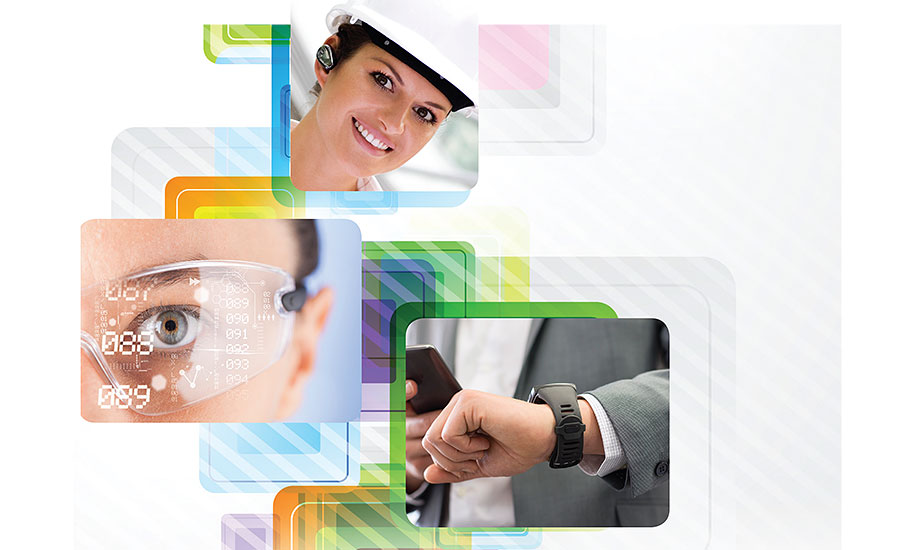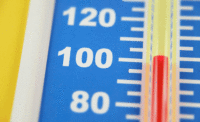The future of wearable sensor technologies “may help revolutionize the practice of industrial hygiene and safety evaluation,” writes NIOSH Director Dr. John Howard in a recent NIOSH blog.
The future of wearables in the workplace is unwritten, filled with promises and potential pitfalls. An EPA science advisor recently said, “We’re at the edge of a technology wave where anyone can use these sensors.” Wearables – miniature electronic sensors embedded in buttons, badges, wristbands, eyeglasses, earpieces, headsets, armbands, vests, other clothing, even tattoos with special inks – are poised to flood the workplace in 2015.
The moment is filled with hype. Googling “wearable sensor technology workplace” brings up phrases such as, “the invasion has begun;” “wearables will be mainstream by 2020;” and “the potential exists to transform the way organizations and workers conduct business.”
You also find stats. Sixty-eight percent of global tech and business leaders see wearables as a priority for their companies. Seventy-three percent of working adults worldwide see at least one benefit of wearables in the workplace, according to the Work Force Institute.
The latest chapter
Wearable sensors are the latest manifestation of an old industrial hygiene concept – miniaturization. “There is an obvious continuum, from the old ‘organ grinder’ pumps you only see in museums to personal sampling pumps to passive collectors and dosimeters,” Dr. Sean Mahar, owner of the consultancy Euro Safety and Health in the United Kingdom, wrote to ISHN in an email.
Wearable devices are best known now for fitness and personal health monitoring applications. Devices such as Fitbit, Nike FuelBand, Jawbone UP, Moto 360 and Pebble Watch track nutrition intake, active calorie burn, sleep patterns, motion, how many steps a person takes during a day, heartbeats, breathing, respiration, and heat stress, among other health and wellbeing metrics. The Apple Watch, which will have hit the market by the time you read this, is expected to ship 15.4 million units globally in 2015, according to the research firm Strategy Analytics. What we could be witnessing as wearables spin off into workplace applications is the consumerization of industrial hygiene and environmental safety and health.
Wearables at work also follow another historical arc. In the 1990s, Bell Canada began outfitting phone technicians with wrist-worn PCs to allow them to enter data from repair sites without walking back to the computers in their trucks – saving each technician almost an hour an day. In 2002, the British asbestos remediation firm OHS outfitted inspectors with belt-mounted computers containing blueprints of buildings and producing analytical recommendations for navigating rooms efficiently and identifying trouble spots. In 2015, mobile workers check their smartphones more than 150 times a day on average, according to the Harvard Business Journal.
Breaking new ground
The frontier of wearable technologies in the workplace is being pioneered by a diverse group of innovators. Patrick Jackson, a firefighter and a member of the Google Glass Explorer program, has developed an app that displays incoming emergency dispatches, shows maps where incidents are, the nearest fire hydrants, and building plans.
In 2012, the EPA and the Department of Health and Human Services (HHS) launched the “My Air, My Health” challenge, aimed at connecting location-specific air pollution data and human health measurements to picture air quality’s impact on health. The winners of the $100,000 competition were three team members who stumbled upon the challenge competition eight days before the deadline for proposals, and they submitted their entry just before midnight on the last day. Their winning entry, the Conscious Clothing™ system, uses a microcomputer that lies against the chest and a particulate matter air sensor that hangs near the neck. Stretchable strips of silver-knitted yarn wrap around the ribcage to measure breathing. Wearers receive an estimate of their pollution exposure by comparing air quality to how deeply the user breathes.
University of California at Berkeley students created a keychain-sized device called Clarity that measures particulate matter in the air as well as temperature and humidity. Sensors measure the size and number of particles before syncing the information, via Bluetooth, with the Clarity app. Clarity also records data and warns users when they’re entering a polluted area. The developers have founded a company and target pollution-ridden countries such as China, Mexico and India as prime markets.
Another startup is TZOA, founded in 2013. Founder and CEO Kevin Hart, has been quoted saying, “It’s time to redistribute environmental governance into the hands of the citizens.” Tzoa uses a laser detector custom miniaturized to fit inside a compact clip-on device to count and size particulate matter. If pollution in a user’s immediate environment spikes, the app sends a notification to a smartphone, delivering a detailed breakdown of the current environment and giving actionable tips to find cleaner exposure areas.
To be sure, at this point in 2015 wearable sensor technologies for work applications are subjects of EPA demonstration projects based on university R&D work, NIOSH research, small start-ups struggling to find funding, and futuristic marketing plans. Devices are not mature yet, but they will evolve rapidly, similar to smartphones and tablets, in the next 18 to 24 months, according to experts.
Disruptive technology
These start-up innovators and entrepreneurs are disrupters. In the same way “citizen journalists” – everyday people using smartphone videos, and instant messaging – have upended traditional news reporting, wearable sensor technology creates “citizen scientists.” Through citizen science, people share and contribute to data monitoring and collection programs as unpaid volunteers.
Bring citizen science into the workplace and you have the potential for everyone becoming their own industrial hygienist. James Leemann, as an assistant professor in Tulane University’s Center for Applied Environmental Public Health, and president of The Leemann Group LLC, hypothesized in an email to ISHN: “Depending on how sophisticated wearable technology becomes, it could revolutionize EHS to the point of working EHS pros out of a job.”
He doubts this will happen in his lifetime, and says “severe regulatory pressure could be the tipping point.”
Empowering employees to monitor their own exposure concerns James Platner, Ph.D., CIH, of the Center to Protect Worker Rights. “Wearable devices can be seen as shifting responsibility and care of monitoring devices to the workers, who may not fully understand sources of interference or typical failure modes of the devices they are expected to wear,” he writes in an email to ISHN. “For the near term, wearable technologies should supplement rather than replace traditional monitoring practices. Their use should be overseen by experienced hygienists, and significant worker training may be required, and an extensive data quality assurance.”
The rest of the story
The “invasion” of wearables into the workplace comes with questions and concerns. Will low-cost ($50 to $75 in some cases) sensors be accurate? How are they to be calibrated and validated? What can be expected of battery life as wearables incorporate more complex electronics and sensors?
Will novice users misinterpret data? Should hazcom training be expanded to cover results from personal wearable sensors? Should employers endorse certain wearable sensors and purchase them for the workforce, as is the practice with personal protective equipment (PPE)? Who gets to use wearables, and who doesn’t need them? Is usage optional, voluntary or mandatory?
What if users of smart eyeglasses experience headaches, double vision and dizziness, as has happened with some surgeons testing prototypes? Should smart eyewear, which can be a distraction while driving, be restricted when employees are behind the wheel to limit liability?
There have been no long-term studies of the health effects of wearables. “There are too many questions about the radiation from these kinds of devices. I much prefer taking the precautionary approach… we’re supposed to practice that as public health professionals,” writes Dorothy Wigmore, an occupational health and green chemistry specialist in Winnipeg, Manitoba.
Coping strategies
It’s not too soon for employers, relying on input from industrial hygienists and others in the EHS field, to develop “accommodation” strategies and policies. How is the avalanche of data from potentially thousands of wearables in a workplace to be collected, organized, analyzed and acted upon? What training programs will be required? How will companies enforce “bring your own wearables” (BYOW) policies, especially with devices being small and inconspicuous? As more and more employees sport wearables at work for non-work reasons, risks of injuries, even fatalities, increase. Think how many times employees check their smartphones during the day.
“Our biggest challenge will be to educate varied stakeholders in the gathering of data and its interpretation so seasoned judgments are part of any dialog,” writes Chris Laszcz-Davis, CIH in an email. “Communication, communication, communication!”
Sidebar1:
The wearable revolution
Q&A with Christine A.D. Lorenzo, CIH, President of the American Industrial Hygiene Association (AIHA) Board of Directors
Are wearable gas sensors really going to revolutionize IH?
I think wearables may have the potential to revolutionize IH provided the sensors are indeed sensitive, specific, highly reliable, and are affordable enough to be widely used.
Do you see specific applications?
If small wearable sensors for particulates and gases were available to use on the workers at the World Trade Center site, and had policy and procedures existed for what to do and when to use respiratory protection, that may have resulted in significantly influencing police, fire and rescue workers to use the respiratory protection and we may have seen less respiratory and other diseases due to the exposures to a mixture of aerosols, gases, vapors and particulates. A sensor in that case that acted as a surrogate for the mixture present may have been a good option.
Imagine the benefit to workers on hydraulic fracturing sites who wear real-time respirable crystalline silica detectors. The workers would have had a real-time understanding of the silica hazard and risk. That technology does not exist right now but it could serve as a clear indicator of the hazard if employed correctly.
Do you see downsides to wearables?
The downside might be analogous to body cameras; the potential exists to become saturated with information and data, but is it data that we ought to be measuring, and who will archive and analyze it?
The main downside I foresee with wearable detector technology is that the benefit is a function of acting appropriately on the information provided by the technology. Workers will have to be taught to trust and act on what the data produced by the technology provides; if they don’t it’s just a gadget that they are forced to wear that may get in the way of them getting their jobs done.
Sidebar 2:
The wearable revolution
Q&A with Daniel H. Anna, Ph.D., CIH, CSP, AIHA President-elect
Are wearable gas sensors really going to revolutionize IH?
As gas sensors become wearable, the opportunities to integrate real-time monitoring into the regular activities and routines of workers will result in a different way of thinking about exposure monitoring. As these sensors become more sophisticated, they have the potential to change the way industrial hygienists view the exposure assessment process. For example, it may provide ways to validate how similar exposure groups are defined. The ability to interpret much larger and more complete sets of data will become a challenge for industrial hygienists and may become a new core competency for the profession.
How many years away is widespread adoption?
Development of different wearable sensors continues at a fairly rapid pace. Widespread adoption will depend on how quickly validation of these new technologies can be completed, and, of course, by cost. Issues related to the sensitivity, specificity, and interferences will need to be documented.
Do you see downsides to wearables?
IHs will need to have (or develop) the skills necessary to determine which portions of that large data sets truly represent the workers potential exposure, and which data are simply additional numbers generated by the technology.
Just like with traditional IH sampling, employees would need to understand the limitations of the wearable. Results would need to be explained to ensure that the interpretation is appropriate for the particular worker in a particular work environment.










